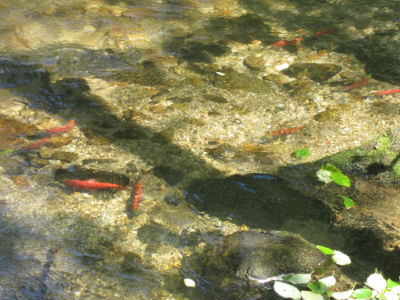“So I say to you, ask, and it will be given to you; seek, and you will find; knock, and it will be opened to you. For everyone who asks receives, and he who seeks finds, and to him who knocks it will be opened. If a son asks for bread from any father among you, will he give him a stone? Or if he asks for a fish, will he give him a serpent instead of a fish? Or if he asks for an egg, will he offer him a scorpion? If you then, being evil, know how to give good gifts to your children, how much more will your heavenly Father give the Holy Spirit to those who ask Him!” Luke 11:9-13
In the US and Canada, there are five species of Pacific salmon: Chinook, Pink, Sockeye, Coho, and Chum salmon. These fish start their lives in freshwater streams, lakes, and/or rivers where the adults spawn and the salmon eggs are deposited in the gravel. As the fish hatch and develop, they migrate to the ocean as small fish, or smolts. When they leave streams and rivers and enter the salt water of the ocean, their kidneys do an amazing thing: they change from storing body salts and pumping out excess water to doing just the opposite. While in the ocean, the fish must now pump out excess salt and conserve water.
The salmon feeds on the relatively abundant food in the ocean compared to that of the fresh water stream. It then returns to fresh water where the kidneys do another change to once again conserve salt and pump out excess water. Amazingly, the adult salmon returns to the same body of water where it was hatched, sometimes traveling hundreds of miles and passing by countless streams and rivers to reach its original spawning area. There the salmon spawns and begins the cycle all over again.
I recently took the above picture of some Kokanee salmon in a nearby stream. Kokanee are a land-locked version of the Sockeye salmon. This means they cannot migrate to the ocean due to some barrier in the river. They feed primarily on zooplankton and small aquatic organisms in the lake they are in, depending on what is available.
The Kokanee are silver with a bluish hue while they are in the lake or large reservoir. And just like their larger counterparts the Sockeye, Kokanee turn a brilliant orange with dark-green heads come spawning time. And like other Pacific salmon, Kokanee die soon after spawning.
How a salmon can not only survive, but thrive, as they change from fresh water to salt water and then back to fresh water is remarkable. That, along with the fish finding its way back to its original home-stream after traveling sometimes over a thousand miles in its lifetime is also astonishing. These are just two features of an amazing fish which point me to an even more amazing Creator Who thought of all this in the first place.
This didn’t happen by chance.
What an amazing God.
Have a great day.
